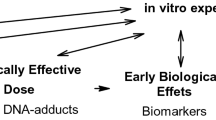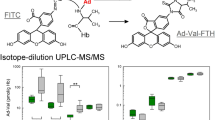Abstract
A new analytical procedure has been developed for the simultaneous determination of human hemoglobin adducts from aromatic amines and tobacco-specific nitrosamines. These tobacco-related hemoglobin adducts were determined in nonsmokers, smokers, and users of nasal snuff. Adducts from aminobiphenyl compounds are good biomarkers of exposure to tobacco smoke; they are not elevated in users of nasal snuff. However, a significant contribution of environmental exposure to aromatic amines and/or the corresponding nitroaromatics makes it difficult to evaluate passive exposure to tobacco smoke. The best biomarkers for exposure to tobacco smoke should in theory be adducts arising from tobacco-specific nitrosamines. The common adduct from N'-nitrosonornicotine and 4-(methylnitrosamino)-1-(3-pyridyl)-1-butanone releases 4-hydroxy-l-(3-pyridyl)1-butanone from hemoglobin upon mild alkaline hydrolysis and only marginal differences are found in the adduct level in smokers and nonsmokers. The reason for this observation is not yet understood and is currently under investigation. However, the adduct formed by tobacco-specific nitrosamines is well suited for the detection of oral and nasal tobacco use. Only by simultaneous determination of both adducts formed by aromatic amines and tobacco-specific nitrosamines is it possible to differentiate between nonsmokers, smokers, and nasal snuff users.
Similar content being viewed by others
Abbreviations
- TSNA:
-
tobacco-specific nitrosamines
- NNN:
-
N'-nitrosonornicotine
- NNK:
-
4-(methylnitrosamino)-1-(3-pyridyl)-1-butanone
- 3-ABP:
-
3-aminobiphenyl
- 4-ABP:
-
4-aminobiphenyl
- ETS:
-
environmental tobacco smoke
- GC:
-
gas chromatography
- Hb:
-
hemoglobin
- HPB:
-
4 hydroxy-l-(3-pyridyl)-1-butanone
- PFPA:
-
pentafluoropropionic anhydride
- PFBC:
-
pentafluorobenzoylchloride
- SIM:
-
selected ion monitoring
- NICI-MS:
-
negative ion chemical ionization mass spectrometry
References
Adams JD, O'Mara-Adams KJ, Hoffmann D (1987) Toxic and carcinogenic agents in undiluted mainstream smoke and sidestream smoke of different types of cigarettes. Carcinogenesis 8:729–731
Anonymous (1988) Organikum, 17th edn. VEB Deutscher Verlag der Wissenschaften, Berlin
Bartsch H, Caporaso N, Coda M, Kadlubar F, Malaveille C, Skipper P, Talaska G, Tannenbaum SR, Vineis P (1990) Carcinogen hemoglobin adducts, urinary mutagenicity, and metabolic phenotype in active and passive cigarette smokers. J Natl Cancer Inst 82:1826–1831
Brunnemann KD, Genoble L, Hoffmann D (1985) N-Nitrosamines in chewing tobacco: an international comparison. J Agric Food Chem 33:1178–1181
Bryant MS, Skipper PL, Tannenbaum SR, Maclure M (1987) Hemoglobin adducts of 4-aminobiphenyl in smokers and nonsmokers. Cancer Res 47:602–608
Bryant MS, Vineis P, Skipper PL, Tannenbaum SR (1988) Hemoglobin adducts of aromatic amines: associations with smoking status and type of tobacco. Proc Natl Acad Sci USA 85:9788–9791
Carmella SG, Hecht SS (1987) Formation of hemoglobin adducts upon treatment of F344 rats with the tobacco-specific nitrosamines 4-(methylnitrosamino)-1-(3-pyridyl)-1-butanone and N'-nitrosonornicotine. Cancer Res 47:2626–2630
Carmella SG, Kagan SS, Kagan M, Foiles PG, Palladino G, Quart AM, Quart E, Hecht SS (1990) Mass spectrometric analysis of tobacco-specific nitrosamine hemoglobin adducts in snuff-dippers, smokers, and non-smokers. Cancer Res 50:5438–5445
Coghlin J, Gann PH, Hammond SK, Skipper PL, Taghizadeh K, Paul M, Tannenbaum SR (1991) 4-Aminobiphenyl hemoglobin adducts in fetuses exposed to the tobacco smoke carcinogen in utero. J Natl Cancer Inst 83:274–280
Dahl AR, Lewis JL (1993) Respiratory tract uptake of inhalants and metabolism of xenobiotics. Annu Rev Pharmacol Toxicol 33:383–407
Del Santo P, Moneti G, Salvadori M, Saltutti C, Delle Rose A, Dolara P (1991) Levels of the adducts of 4-aminobiphenyl to hemoglobin in control subjects and bladder carcinoma patients. Cancer Lett 60:245–251
Haley NJ Axelrad CM Tilton KA (1983) Validation of self-reported smoking behavior: biochemical analyses of cotinine and thiocyanate. Am J Publ Health 73:1204–1207
Hammond SK Coghlin J Gann PH Paul M Taghizadeh K Skipper PL Tannenbaum SR (1993) Relationship between environmental tobacco smoke exposure and carcinogen-hemoglobin adduct levels in nonsmokers. J Nat Cancer Inst 85:474–478
Hecht SS, Chen CB, Dong M, Ornaf RM, Hoffmann D, Tso TC (1977) Chemical studies on tobacco smoke LI: studies on non-volatile nitrosamines in tobacco. Beitr Tabakforsch 9:1–6
Hecht SS, Carmella SG, Foiles PG, Murphy SE, Peterson LA (1993) Tobacco-specific nitrosamine adducts: studies in laboratory animals and humans. Environ Health Perspect 99:57–63
Hoffmann D, Hecht SS (1990) Advances in tobacco carcinogenesis. In: Cooper CS, Grover PL (eds) Chemical carcinogenesis and mutagenesis, Handbook of Experimental Pharmacology, vol I/3. Springer, Berlin Heidelberg New York, pp 63–102
Hong J-Y, Ding X, Smith TJ, Coon MJ, Yang CS (1992) Metabolism of 4-(methylnitrosamino)-1-(3-pyridyl)-1-butanone (NNK), a tobacco-specific carcinogen, by rabbit nasal microsomes and cytochrome P450s NMa and NMb. Carcinogenesis 13:2141–2144
International Agency for Research on Cancer (1985) IARC monographs on the evaluation of the carcinogenic risk of chemicals to humans, vol 37. Tobacco habits other than smoking; betel-quid and areca-nut chewing; and some related nitrosamines. IARC, Lyon
International Agency for Research on Cancer (1986) IARC monographs on the evaluation of the carcinogenic risk of chemicals to humans, vol 38. Tobacco smoking. IARC, Lyon
Jarvis M, Tunstall-Pedoe H, Feyerabend C, Vesey C, Saloojee Y (1984) Biochemical markers of smoke absorption and self-reported exposure to passive smoking. J Epidemiol Commun Health 38:335–339
Klus H, Begutter H, Scherer G, Tricker AR, Adlkofer F (1992) Tobacco-specific and volatile N-nitrosamines in environmental tobacco smoke of offices. Indoor Environ 1:348–350
Langone JJ, Gijka HB Vunakis HV (1973) Nicotine and its metabolites. Radioimmunoassays for nicotine and cotinine. Biochemistry 12:5025–5030
Maclure M, Katz RB-A, Bryant MS, Skipper PL, Tannenbaum SR (1989) Elevated blood levels of carcinogens in passive smokers. Am J Publ Health 79:1381–1384
Murphy SE, Heiblum R (1990) Effect of nicotine and tobacco-specific nitrosamines on the metabolism of N'-nitrosonornicotine and 4-methylnitrosamino)-1-(3-pyridyl)-1-butanone by rat oral tissue. Carcinogenesis 11:1663–1666
Österdahl B-G (1991) Occurrence of and exposure to N-nitrosamines in Sweden: a review. In: O'Neill IK, Chen J, Bartsch H (eds) Relevance to human cancer of N-nitroso compounds, tobacco smoke and mycotoxins. IARC Scientific Publication 105, pp 235–237. International Agency for Research on Cancer, Lyon
Patrianakos C, Hoffmann D (1979) Chemical studies on tobacco smoke LXIV. On the analysis of aromatic amines in cigarette smoke. J Anal Toxicol 3:150–154
Perera FP, Santella RM, Brenner D, Poirier MC, Munshi AA, Fischman HK, Ryzin JV (1987) DNA adducts, protein adducts, and sister chromatid exchange in cigarette smokers and nonsmokers. J Natl Cancer Inst 79:449–456
Richter E, Tricker AR (1994) Nicotine inhibits the metabolic activation of the tobacco-specific nitrosamine 4-(methylnitrosamino)-1-(3-pyridyl)-1-butanone in rats. Carcinogenesis (in press)
Richter E, Schäffler G, Malone A, Schulze J (1992) Tobacco-specific nitrosamines — metabolism and biological monitoring of exposure to tobacco products. Clin Investig 70:90–294
Ries J (1992) Qualitative und quantitative Bestimmung von Nitrokohlenwasserstoffen in Automobilabgasen. Thesis, University of Heidelberg
Schäffler G, Betz C, Richter E (1993) Mass spectrometric analysis of tobacco-specific hemoglobin adducts. Environ Health Perspect 99:187–189
Skipper PL, Tannenbaum SR (1990) Protein adducts in the molecular dosimetry of chemical carcinogens. Carcinogenesis 11:507–518
Tricker AR, Preussmann R (1991) Occurrence of and exposure to N-nitroso compounds in tobacco. In: O'Neill IK, Chen J, Bartsch H (eds) Relevance to human cancer of N-nitroso compounds, tobacco smoke and mycotoxins, IARC Scientific Publications 105, pp 493–495. International Agency for Research on Cancer, Lyon
Tricker AR, Ditrich C, Preussmann R (1991) N-Nitroso compounds in cigarette tobacco and their occurrence in mainstream tobacco smoke. Carcinogenesis 12:257–261
Tricker AR Scherer C Conze C Adlkofer F Pachinger A Klus H (1993) Evaluation of 4-(N-methylnitrosamino)-4-(3-pyridyl)butyric acid as a potential monitor of endogenous nitrosation of nicotine and its metabolites. Carcinogenesis 14:1409–1414
Vineis P, Caporaso N, Tannenbaum SR, Skipper PL, Glogowski J, Bartsch H, Coda M, Talaska G, Kadlubar F (1990) Acetylation phenotype, carcinogen-hemoglobin adducts, and cigarette smoking. Cancer Res 50:3002–3004
Weston A, Caporaso NE, Taghizadeh K, Hoover RN, Tannenbaum SR, Skipper PL, Resau JH, Trump BF, Harris CC (1991) Measurement of 4-aminobiphenyl-hemoglobin adducts in lung cancer cases and controls. Cancer Res 51:5219–5223
Author information
Authors and Affiliations
Rights and permissions
About this article
Cite this article
Falter, B., Kutzer, C. & Richter, E. Biomonitoring of hemoglobin adducts: aromatic amines and tobacco-specific nitrosamines. Clin Investig 72, 364–371 (1994). https://doi.org/10.1007/BF00252829
Received:
Revised:
Accepted:
Issue Date:
DOI: https://doi.org/10.1007/BF00252829




